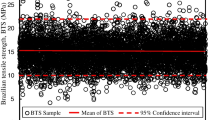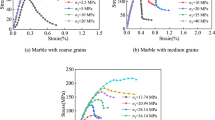Abstract
Direct and indirect test procedures are utilized to provide tensile strengths of rock and concrete samples. While the measurements provided by these methods are considered as identical in theory, a difference between the values is recorded in practice. To provide an association between the tensile test methods, a data-driven algorithm for identifying the uncertainty systems has been suggested. This study presents a novel algorithm including two steps: data processing-fusion and simulation. In the first step, both random and systematic error components in the tensile strength testing procedures are fused by uncertainty treatment-based data processing. By this way, instead of some assumptions and descriptive statistics, a data-fusion method is adapted. After that, a Monte Carlo simulation is performed using parametric and nonparametric probability distributions. Thus, a concurrency between the tensile strength procedures including strength values and uncertainty intervals is provided. The case study implemented by a real data set showed that the proposed algorithm has a feature of transparency, flexibility and also accuracy. The density functions used in the simulations do not require being normal while the conventional uncertainty-based data processing, Taylor’s ISO-GUM method depends on the normality. In addition, the algorithm does not need specification of coverage factor and it also works without any sensitivity coefficient. The methodology can be recommended to provide an agreement between the tensile strength values of rocks especially with limited number of data.








Similar content being viewed by others
References
Paterson MS, Wong T-F (2005) Experimental rock deformation—the brittle field, 2nd edn. Springer, Berlin
Perras MA, Diederichs MS (2014) A review of the tensile strength of rock: concepts and testing. Geotech Geol Eng 32:525–546
Moss RES (2008) Quantifying measurement uncertainty of thirty meter shear wave velocity (VS30). Bull Seismol Soc Am 98(3):1399–1411
Kuhinek D, Zoric I, Hrzenjak P (2011) Measurement uncertainty in testing of uniaxial compressive strength and deformability of rock samples. Meas Sci Rev 11(4):112–117
Dhoska K, Tola S, Pramono A, Vozga I (2018) Evaluation of measurement uncertainty for determination the mechanical resistance of the brick samples by using uniaxial compressive strength test. Int J Metrol Qual Eng 9(12):1–5
Koepke A, Lafarge T, Possolo A, Toman B (2017) Consensus building for interlaboratory studies, key comparisons, and meta-analysis. Metrologia 54:S34–S62
Lysiak-Pastuszak E (2004) Interlaboratory analytical performance studies; a way to estimate measurement uncertainty. Oceanologia 46(3):427–438
Rukhin AL (2009) Weighted means statistics in interlaboratory studies. Metrologia 46:323–331
Wang CM, Iyer HK (2010) On multiple-method studies. Metrologia 47:642–645
Da Silva RJNB, Ricardo JNB, Pennecchi FR, Hibbert DB, Kuselman I (2018) Tutorial and spreadsheets for Bayesian evaluation of risks of false decisions on conformity of a multicomponent material or object due to measurement uncertainty. Chemom Intell Lab Syst 182:109–116
Petosic A, Djurek I, Suhanek M, Grubesa S (2019) Interlaboratory comparisons’ measurement uncertainty in the field of environmental noise. Measurement 148:106932
Pendrill LR (2014) Using measurement uncertainty in decision-making and conformity assessment. Metrologia 51:S206–S218
Erarslan N, Williams DJ (2012) Experimental, numerical and analytical studies on tensile strength of rocks. Int J Rock Mech Min Sci 49:21–30
Tutmez B, Unver B (2017) Uncertainty-based analysis for agreement of tensile-strength measurement procedures. Geotech Test J 40:506–514
Ghamgosar M, Erarslan N, Williams DJ (2017) Experimental investigation of fracture process zone in rocks damaged under cyclic loadings. Exp Mech 57:97–113
Hudson JA, Harrison JP (2000) Engineering rock mechanics: an introduction to principles. Elsevier, Amsterdam
Brisevac Z, Kujundzic T, Cajic S (2015) Current cognition of rock tensile strength testing by Brazilian test. Min Geol Pet Eng Bull 30(2):101–114. https://doi.org/10.17794/rgn.2015.2.2
ISRM (2007) Suggested methods for determining tensile strength of rock materials. In: Ulusay R, Hudson JA (eds) The complete ISRM suggested methods for rock characterization, testing and monitoring: 1974–2006. ISRM Turkish National Group, Ankara
Singh PK, Tripathy A, Kainthola A, Mahanta B, Singh B, Singh TN (2017) Indirect estimation of compressive and shear strength from simple index tests. Eng Comput 33:1–11
Rabinovich SG (2017) Evaluating measurement accuracy. Springer, Switzerland
JCGM 100 (2008) Evaluation of measurement data—guide to the expression of uncertainty in measurement, BIPM, Serres, France
Shaw BD (2017) Uncertainty analysis of experimental data with R. CRC Press, Boca Raton
Adachi K (2016) Matrix-based introduction to multivariate data analysis. Springer, Singapore
Servin C, Ceberio M, Jaimes A, Tweedie C, Kreinovich V (2013) How to describe and propagate uncertainty when processing time series: metrological and computational challenges, with potential applications to environmental studies. In: Chen SM, Pedrycz W (eds) Time series analysis, modeling and applications: a computational intelligence perspective. Springer, Berlin, pp 279–299
Servin C, Kreinovich V (2015) Propagation of interval and probabilistic uncertainty in cyberinfrastructure-related data processing and data fusion. Springer, Cham
Unpingco J (2015) Python for probability, statistics, and machine learning. Springer, Cham
Efron B, Tibshirani RJ (1993) An introduction to the Bootstrap. Chapman and Hall, London
Efron B (2011) The bootstrap and Markov-chain Monte Carlo. J Biopharm Stat 21:1052–1062
Gorski B, Conlon B, Ljunggren B (2007) Determination of the direct and indirect tensile strength on cores from borehole KFM01D, SKB Report—SKB P-07-76, Sweden
Astrua M, Ichim D, Pennecchi F, Pisani M (2007) Statistical techniques for assessing the agreement between two instruments. Metrologia 44:385–392
Efron B, Hastie T (2016) Computer age statistical inference. Cambridge University Press, Cambridge
Charki A, Pavese F (2019) Data comparisons and uncertainty: a roadmap for gaining in competence and improving the reliability of results. Int J Metrol Qual Eng 10(1):1–10
Coleman HW, Steele WG (2018) Experimentation, validation, and uncertainty analysis for engineers. Wiley, Chichester
Acknowledgements
The author extends the appreciation to Editor-in-Chief Professor Mark Shephard and anonymous reviewers for the constructive comments.
Author information
Authors and Affiliations
Corresponding author
Additional information
Publisher's Note
Springer Nature remains neutral with regard to jurisdictional claims in published maps and institutional affiliations.
Rights and permissions
About this article
Cite this article
Tutmez, B. Statistical learning algorithm for concurrency of tensile strength tests. Engineering with Computers 37, 1781–1789 (2021). https://doi.org/10.1007/s00366-019-00911-0
Received:
Accepted:
Published:
Issue Date:
DOI: https://doi.org/10.1007/s00366-019-00911-0




